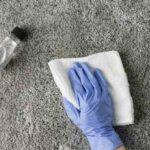Rugs are a popular addition to any home, but in order to enhance their appearance and keep them free of dirt and dust, they need regular vacuuming. With so many different types of rugs available, it can be confusing knowing how to vacuum your rugs safely and correctly. So here’s everything you need to know.
The reality is, there is no one single way to vacuum a rug. It really does depend on how a rug has been constructed, its materials, and its pile length. But, once you know the basics, and the processes for vacuuming each type of rug correctly, the rest is easy.
1. The importance of regular rug vacuuming
Rugs are notorious for collecting dust, dirt, dander and other debris, so you should aim to vacuum your rugs at least once or even twice per week. Rugs in high-traffic areas such as hallways and entrances, and rugs used by pets, may need vacuuming more frequently, whereas rugs in low-traffic areas may only need vacuuming once every fortnight.
This is a general guideline, and may need to be tweaked according to the type of rug you own. For example, not all rugs are suitable for vacuuming, in which case, you may need to shake or beat them outside, instead, or use a special type of brush.
Either way, removing the dust and grime that can gather in a rug is important, because, over time, particles of dirt can be abrasive to the delicate strands in a rug, causing them to tear and even fall out. When you’ve spent lots of money on a luxurious rug or a beautiful Oriental rug, maintaining its good condition and preventing such damage from occurring will be important – and that’s where vacuuming and a robust cleaning routine will play a crucial role.
2. Pick the perfect vacuum cleaner
The type of vacuum cleaner you own is really important to make sure your rugs are being cleaned correctly, safely and thoroughly. If you own rugs that have different types of materials and pile lengths, it’s a good idea to get a vacuum cleaner that can be adjusted, according to things like pile height and suction power.
Choose a vacuum cleaner that comes with suitable attachments that allows you to clean different types of rugs. For example, an upholstery attachment can be useful for cleaning hand-knotted rugs.
3. Know your rugs
By understanding what type of rugs you own, you can then make sure they receive the correct method of vacuum cleaning, attachment use, cleaning direction and whether they can be vacuumed on both sides.
4. The right technique
Before you start vacuuming, check the rug, especially if it’s a long, shag pile rug, to make sure there aren’t any large bits of dirt, pennies, small pieces of Lego or other toys, etc, hiding inside fibres, which could damage your hoover.
When vacuuming any type of rug, always start slowly, using short strokes, and take your time. Overlap the strokes so you cover all areas of the rug. Be careful when cleaning towards the edges of the rug that it doesn’t get caught in the beater bar, leading to fraying of fabrics. Hold the edges down with your feet as you vacuum the rug, or use an attachment designed for rug edges.
As a general guideline, use the higher setting on your vacuum cleaner for plush or high-pile rugs, and the lower setting for low-pile rugs.
If you have a rug that has a stain, don’t try to vacuum when the stain is wet; it could damage the rug. Wait until the stain is dry before vacuuming up any debris before correctly treating the stain.
At the end of each clean, always empty the bag or collecting unit, and clean any of the attachments so they’re in the optimum condition next time you vacuum. If you use a cordless vacuum cleaner, make sure it’s fully charged before each clean.
5. Woven rugs
If you have woven rugs, the first thing you need to do before you begin vacuuming is to identify the direction of the pile. Run your hand along the pile, and if you feel resistance, this means you are brushing against the pile.
If you vacuum against the pile, this could be harmful to rug fibres, but if you vacuum towards the pile, you’re pushing the fibres over any dirt, making it harder to remove. Therefore, the most effective technique for retrieving dirt safely is to vacuum at a perpendicular angle to the direction of the pile.
A vacuum cleaner can be used directly on a woven rug which has a thick pile, but for thinner pile rugs, use the upholstery attachment.
Don’t forget to vacuum on the reverse side of the rug.
6. Tufted rugs
If you have tufted rugs, the first thing you should do is check that all of the tufts in the rug are securely in place and there aren’t any loose fibres. The tufts are glued onto the rug, so if you notice any cracking or patches on the underside of the rug, this could indicate that the tufts aren’t secure, so you’ll need to vacuum the rug very gently, preferably with a canister vacuum that doesn’t have a beater bar.
Identify the pile direction first, by brushing your hand along the fibres. You’ll brush against the pile when you feel resistance, and where the rug looks slightly darker. As with woven rugs, you’ll get the best results when vacuuming perpendicularly to the direction of the pile.
Use an upholstery attachment for thinner rugs, and the vacuum’s power brush for rugs made from thicker fabrics.
7. Flat weave rugs
As flat weave rugs don’t have a pile, you don’t need to worry about which direction you vacuum the rugs in.
It’s important to vacuum both sides of flat weave rugs on a regular basis, as the lack of pile means that dirt can look more visible in the rug.
8. Shag pile rugs
If you have a deep, shag pile rug, turn it over and use a vacuum cleaner with a beater bar to clean this side of the rug first. Alternatively, shake the loose dust and dirt from the rug outside.
As a shag pile rug has long fibres, the topside isn’t suitable for vacuuming with a beater bar, as the strands could get tangled inside the machine. Instead, use a vacuum cleaner with a low suction, which won’t pull at the tufts in the rug. Work slowly and carefully, and stop if you notice any fibres pulling. If your vacuum cleaner comes with a crevice tool, this can also be used to clean the topside of the rug.
9. Other rugs
If you have rugs made from sheepskin or fur, these aren’t suitable for vacuum cleaning. Use a specially designed brush to loosen dirt and to prevent matting. Older or antique rugs might also be unable to withstand vacuuming, so use a brush on these.
Silk rugs also need specialist care because of their delicate nature, so don’t use a roller brush, and if you do vacuum them, use the upholstery attachment.
10. Rugs with fringes or tassels
It’s not a good idea to vacuum the fringe lining of a rug, as it could cause damage to both the rug and your vacuum cleaner. As it can be tricky to vacuum a rug with fringing without it accidentally getting tangled in the beater bar, place your hand or foot on the fringing when hoovering the main body of the rug. Alternatively, switch the beater bar function off when vacuuming, use a canister vacuum or clean fringes or tassels by hand.
11. Professional rug cleaning
If you don’t feel confident vacuuming a rug yourself, or you own a specialist type of rug, it’s a good idea to seek assistance from a professional rug cleaning company. Even if you regularly vacuum your rugs correctly and safely, they’ll still need professional cleaning every so often to provide them with a full, deep clean, and to remove the ingrained dirt and debris that the average vacuum cleaner can’t access.
At our rug cleaning spa in London, we’ll make sure your rugs receive the right kind of vacuuming and deep cleaning care and attention they need. Carpet Bright UK also offers domestic and commercial customers on-site and off-site rug cleaning services, with free rug collection and delivery, making it easy and affordable to get your rugs cleaned with us.







